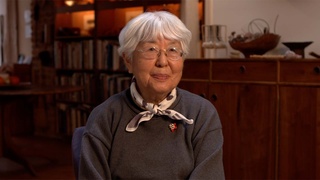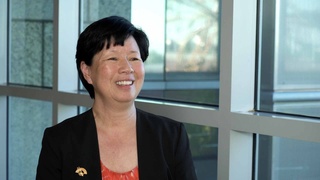Interviews
Helping soldiers
On the grass outside, there weren't even enough blankets for the soldiers. And so all the casualties were lying down on the grass. And one man I remember vividly, he was a young guy, a blond soldier. He must've been 18 or 19. And I was looking after him and he had asked me to write a letter to his mother. So, with only eighth grade education, I couldn't do much. But, he dictated. So I did write the letter for him and he gave me the address to mail the letter. The next morning, I went back to him and he was gone. He passed away that night.
And so, funny how we were really just exposed to all the wartime things. The Army trucks just park in front—our plantation camp was filled with all the trucks and everything. So it scared us, we couldn't go out.
And then, what's funny, two weeks later, I received a letter from Washington D.C. from the Army Department. They had checked our background. They found out that I was an alien. And so they said, We appreciate your support and everything, and You did a good... I still have the letter, you know. And so then, being an alien, I'm sorry but that's about it, you know. And they didn't want me to help anymore. And so I think all my friends, I think, were eliminated from helping. But, that was kind of sad. So, because we grew up during wartime, I think it made it kind of difficult, too. I was considered an alien, I couldn't go out after 6 pm. I couldn't work near Army post. And so, it was kind of difficult for me.
Date: February 19, 2004
Location: Hawai'i, US
Interviewer: Lisa Itagaki, Krissy Kim
Contributed by: Watase Media Arts Center, Japanese American National Museum.
Explore More Videos

The lack of discussion about family’s incarceration in Amache
Sansei judge for the Superior Court of Los Angeles County in California


Her brother’s reasons as a No-No Boy
(b. 1923) Japanese American poet, activist

Her grandfather was pressured to teach Japanese
Sansei judge on the Superior Court of Los Angeles County in California

Neighbor took care of her mother after grandfather was taken by FBI
Sansei judge on the Superior Court of Los Angeles County in California

Immediately after the bombing
(b. 1938) Japanese American. Hiroshima atomic bomb survivor

Other family members not as lucky
(b. 1938) Japanese American. Hiroshima atomic bomb survivor

His parents had little hope that he had survived the atomic bomb
(b. 1938) Japanese American. Hiroshima atomic bomb survivor

His views on nuclear weapons
(b. 1938) Japanese American. Hiroshima atomic bomb survivor

Loss When Leaving for Manzanar
Japanese American animator for Walt Disney and Hanna Barbera (1925-2007)

Forcibly deported to the U.S. from Peru
(b. 1936) Japanese Peruvian incarcerated in Crystal City

Stories of Grandfather at a concentration camp in Fusagasuga
(b.1974) Japanese Colombian who currently resides in the United States

Her grandfather in a concentration camp in Fusagasuga (Spanish)
(b.1974) Japanese Colombian who currently resides in the United States

Family welcomed at Crystal City
(b. 1936) Japanese Peruvian incarcerated in Crystal City

First meal at Crystal City
(b. 1936) Japanese Peruvian incarcerated in Crystal City
